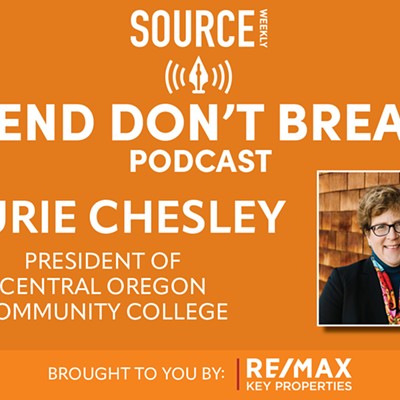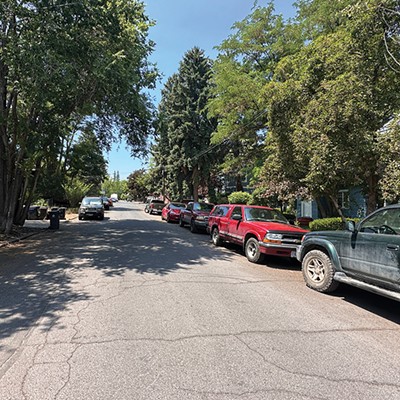ike many Central Oregon Community College students, Tara Vanderhoof, 25, uses public transportation to get to and from school. Without it, she said she wouldn't have a way to get to class.
"I would have to walk three hours, one way," she said as she waited for a lift at the Hawthorne Station near the Third Street Safeway last week.
Vanderhoof lives on the south end of Bend and, as it is, takes a 45-minute bus trip every day from her house to the college.
While that ride is pretty much guaranteed until 2015, what happens after that is anyone's guess.
That's because the future of the city's transit system is in real jeopardy. The city of Bend currently funds about half of the Bend Area Transit's $2.3 million budget. But only until 2015. After that the Bend City Council may choose to redirect those funds back to city expenses like police, fire and public works projects.
"We have this transit system, and people rely on it, and I think they assume that it's just going to be here, but the future is far from certain," explained Scott Aycock, transportation planner with Central Oregon Intergovernmental Council, which manages BAT and the area's rural transit routes.
This is a big problem for a city with plans to build a four-year university in the middle of town and an interest in developing its economy. It's also something you need to start paying attention to, because if we want a transit system, the people of Bend are going to have to start paying for it.
THE NEED IS THERE, THE MONEY IS NOT
Already, rural routes are being curtailed.
"In October, we made two main cuts. Now there are less community connector shuttle runs, and we reduced Dial-a-Ride service area," said Aycock.
These rural routes link up with city routes and allow people from the surrounding areas to get to work or school in Bend and back home again. The entire program is called East Cascades Transit, but the Bend routes are referred to as Bend Area Transit.
More than 75 percent of the people using community connector buses are doing so for work or school purposes, according to a recent survey.
"A lot of this is about independence. It's a popular thing to talk about pulling yourself up by your bootstraps, and this is a way to support that," said Aycock. "A lot of people can't afford to live in Bend, but they work in Bend and it gives them the autonomy and access to do that."
Scott Cooper, executive director of NeighborImpact, works with low-income Deschutes County residents, who make up a large portion of the consistent ridership on the Bend transit system. He agrees that functioning public transit is essential to a growing community.
"Transit equals opportunity," said Cooper. "If you want people to work, you have to have a way to get them to work. A car is an expensive luxury for some households."
But while Central Oregon residents of every political stripe are in favor of putting people to work, so far, there has been little support for a transit system—that critical link between home and work for the area's low-income population.
In 2000, a ballot measure that would have helped fund public transit was voted down. In November 2004, a proposed property tax to specifically fund a fixed-route bus system was also shot down by voters, 53 percent to 41 percent.
It was at this point that the Bend City Council made the controversial decision to push ahead and create the former Bend Area Transit system anyway.
At the time, it was a hugely unpopular plan, made more so by a fiasco around the purchase of the first BAT buses. The city paid about $220,000 to Transit Sales International, a Southern California bus company, for the fleet of six buses.
The Utah Transit Authority had previously owned the buses, but had sold them to the Transit Sales for scrap for less than $2,000 each, according to media reports at the time.
It eventually came to light that at least some city of Bend employees had grave concerns about the quality of the buses before the purchase, but the city bought them anyway.
The city went on to perform more than $100,000 in maintenance on the buses before suing Transit Sales. That suit was eventually dropped and the city later sold the buses for about $2,400 total.
This rocky start has dogged the reputation of the transit system, but the program has been successful in growing routes and serving the area's neediest.
COIC staff estimate that a million trips are made every year on the region's transit system. More than 60 percent of riders of the region's longer community connector trips make less than $15,000 a year, according to a recent COIC survey.
The study also showed that, without transit, many wouldn't have been able to make the trip they were on.
HOW MUCH SHOULD OSU-CASCADES PAY?
The timing of the funding lapse potentially coincides with the opening of Oregon State University-Cascade's four-year campus.
It is hoped that the city would be willing to extend the current funding agreement, rather than let the money run out, leaving the transit system with a budget reduced by half, but a long-term solution is still in the works.
"We would want to work with public transit groups and officials to help our students have means to get to school other than driving in their cars," said Christine Coffin, director of communications at OSU-Cascades. "We're hoping we can find ways that students can bike or walk or ride public transit. We would need a shuttle to go between campuses."
Right now, it is too early in development to know what agreement could be forged between OSU Cascades and CET, but Aycock hopes it would include a group pass system for students that would provide funding for expanded service. COCC has been in discussions with COIC about group passes for students, who make up the largest group of transit riders in Bend. This support could make up some of the difference, but not all of it.
SOLVING THE PROBLEM MEANS STEPPING UP
The answer to keeping these people working and going to school is more money for transit. Right now, COIC is trying to find it.
"We collect funding from a variety of sources, mostly state and federal funding and from the city of Bend. We are looking for a more permanent solution that has some more certainty to it," said Alan Unger, who is the director of the COIC board and also a Deschutes county commissioner.
Finding more stable funding hasn't been easy.
"We've found that the typical models for supporting transit—like property tax, employer taxes, sales tax, and gas tax—we don't see those as viable options for the large Central Oregon area with a small population," said Unger.
To find a solution, two organizations are researching the future of the transit system.
The Bend Metropolitan Planning Organization is looking at future costs and service needs through its Bend Transit Plan. This needs assessment will likely be presented to the Bend City Council this spring.
COIC is drafting a second plan, the Regional Transit Master Plan. This plan will look at how to fund future trasit. It should be completed by June.
Tyler Deke, manager of the Bend Metropolitan Planning Organization, hopes the two planning efforts will help voters understand transit needs better.
That's right. He said voters. Because the most reasonable source of stable funding would likely be a taxing district much like the Bend Park & Recreation District.
Deke said these plans will lay the groundwork for bringing a new vote on funding transit to the public.
"Our plan lays out a very detailed set of improvements and enhancements in a clear manner. For X amount of money, you can get X increase in service. It lays out a plan for improving our transit system over time, and if they do go before a public vote we can use the plan to scale the funding for the future," said Deke.
What this means for regular citizens is that now is the time to pay attention. The decisions made in the next six months will likely shape our transit program—and our property taxes—for years to come.
"If the community would generate a dedicated fund, we would be able to count on it, and the city would be able to use those general fund dollars for other public services," said Aycock. "I look forward to the day when Bend can boast of a transit system that rivals the kick-ass brewpubs, coffee shops and outdoor activities."

























